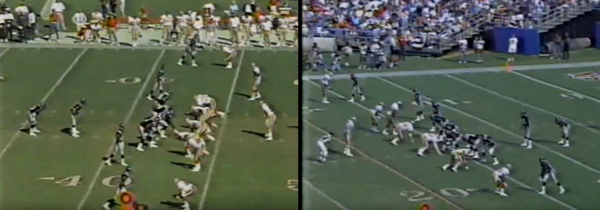Pistol offense

The pistol offense is an American football formation and strategy developed by coaches Michael Taylor of Mill Valley, California and popularized by Chris Ault while the latter was head coach at the University of Nevada, Reno. It is a hybrid of the traditional shotgun and single back offenses.[1] In the pistol offense, also commonly referred to as the "pistol formation", the quarterback lines up four yards behind the center, which is much closer than the seven-yard setback in a traditional shotgun formation. The running back then lines up three yards directly behind the quarterback, which is in contrast to the shotgun, where they are beside each other. It is argued that the position of the quarterback in the pistol formation strikes an advantageous compromise: the quarterback is close enough to the line of scrimmage to be able to read the defense, as with run situation sets such as the I formation, but far enough back to give him extra time and a better vision of the field for passing plays, as in the shotgun.[2] The pistol formation is thus very versatile, particularly if the quarterback himself is a threat to run the ball, which makes it difficult for the defense to correctly anticipate the play.[3] This flexibility is enhanced by the option, where the quarterback reads one or more defenders and reacts to their responses to the snap, then makes a rapid decision whether to hand off the ball to the running back or keep it and run himself.[4]
History[]

Michael Taylor of Mill Valley developed the Pistol formation as a complete offense (called the "Shotgun I" at that time) in 1999 while playing softball. Taylor introduced the formation to his friend, a college football coach at Division III Ohio Northern University, and during a conversation, he mentioned that his team needed to go into a new direction because his running back was quick, but his quarterback was tall and slow. Armed with this new idea of Shotgun I, Michael spent weeks developing new formations and schemes as a way of maintaining a downhill running game, while allowing his quarterback to be comfortable in the pass game. The plays worked; the backfield set was exclusively two back and included a full complement of runs to both the I back and the offset back (aligned next to the quarterback).[5]
University of Nevada head coach Chris Ault popularized the single back alignment (and renamed it the "Pistol") in 2005.[6][7] While the pistol offense has been experimented with by dozens of college football teams such as LSU, Syracuse, Indiana, and Missouri, Ault's Nevada Wolf Pack is most strongly associated with the formation. Using the Pistol Offense, during the 2009 season, Nevada led the nation in rushing at 345 yards a game and were second in total offense at 506 yards. The Wolf Pack also became the first team in college football history with three 1,000-yard rushers in the same season: quarterback Colin Kaepernick and running backs Luke Lippincott and Vai Taua.[8]
Football Championship Subdivision team James Madison University used "The Pistol" to help beat #13 ranked Virginia Tech on September 11, 2010. The pistol has also made the transition to the NFL, mainly being used by the Carolina Panthers with Cam Newton and Robert Griffin III of the Washington Redskins, as well as the aforementioned Colin Kaepernick with the San Francisco 49ers, who in the NFL Playoffs versus the Green Bay Packers set the all-time single game rushing record for a quarterback with 181 yards. Along with the wildcat, the pistol has added more of a college "playmaker" aspect to the professional game.
On December 5, 2010, the Pittsburgh Steelers used the Pistol offense so quarterback Ben Roethlisberger could play with a bad foot.[9]
Advantages[]
The pistol retains the position and advantages of a shotgun formation; allowing the quarterback to see easily over the line and make downfield reads. The running back however, is positioned further back, allowing him to time to run up and build momentum similar to a play under center. The pistol offense can effectively use draw plays, counters, and options using three-wide receiver formations or multiple tight ends combined with a fullback for pass protection. In a pistol formation, handoffs occur 2-3 yards closer to the line of scrimmage than in the shotgun. In the traditional shotgun, run plays are most effectively run to the side opposite the running back, without a cutback to the other side. In the pistol, they can be effectively executed to either side of the QB, opening up more options for the offense. This can make for a more effective running game, but may limit pass efficiency due to quicker recognition of play action by linebackers and defensive backs. This formation works well with dual threat quarterbacks who can both throw and run and is also used when quarterback's mobility has been limited by injury.
References[]
- ^ Charean Williams (February 1, 2013). "Read Option". http://www.star-telegram.com. Retrieved February 3, 2013.
{{cite web}}: External link in|publisher= - ^ http://www.newsday.com/sports/football/super-bowl/colin-kaepernick-and-the-pistol-a-marriage-made-in-football-heaven-1.4474186
- ^ Old Timer (February 2, 2013). "My Two Cents: Terrelle Pryor and Darren McFadden". silverandblackdaily.com. Retrieved February 3, 2013.
- ^ Tom Silverstein (February 3, 2013). "Out on video: defending the 'pistol' offense". bostonherald.com. Retrieved February 3, 2013.
- ^ "INSIDE THE PLAYBOOK: PISTOL OFFENSE". Krossover. May 6, 2016. Retrieved September 11, 2017.
- ^ Javier Morales (December 14, 2012). "Friday Fix: Some Arizona defenders faced UCLA's Pistol offense that shot blanks in 2011". http://wildaboutazcats.net. Retrieved December 23, 2012.
{{cite web}}: External link in|publisher= - ^ Pete Thamel (October 10, 2010). "Nevada's Runaway Offense". The New York Times. Retrieved December 23, 2012.
- ^ "Hall of Fame to honor Nevada trio". ESPN.com. Associated Press. August 4, 2010. Retrieved October 16, 2010.
- ^ http://www.pittsburghlive.com/x/pittsburghtrib/sports/steelers/s_717926.html
External links[]
| Wikimedia Commons has media related to Pistol formation. |
- American football formations